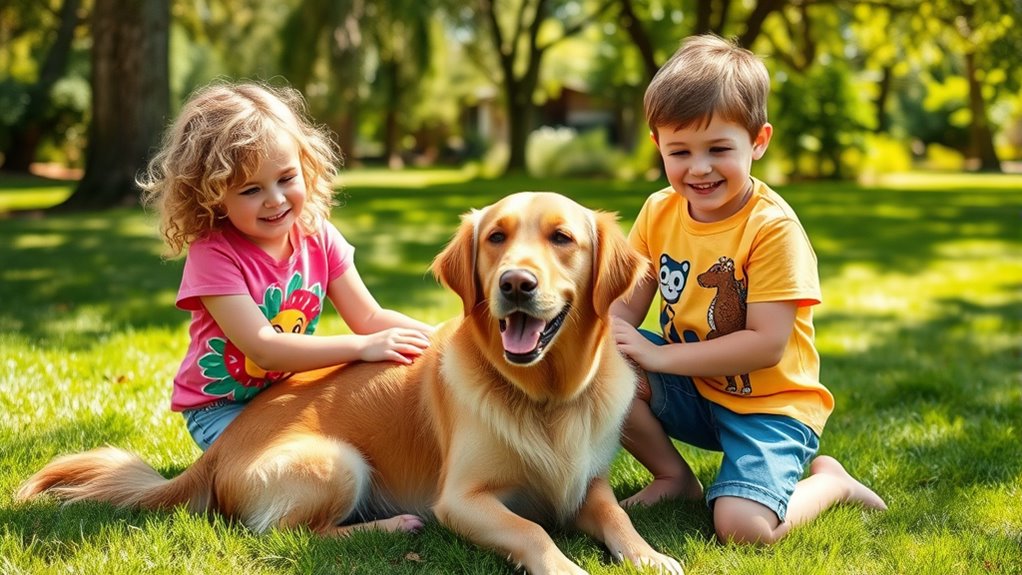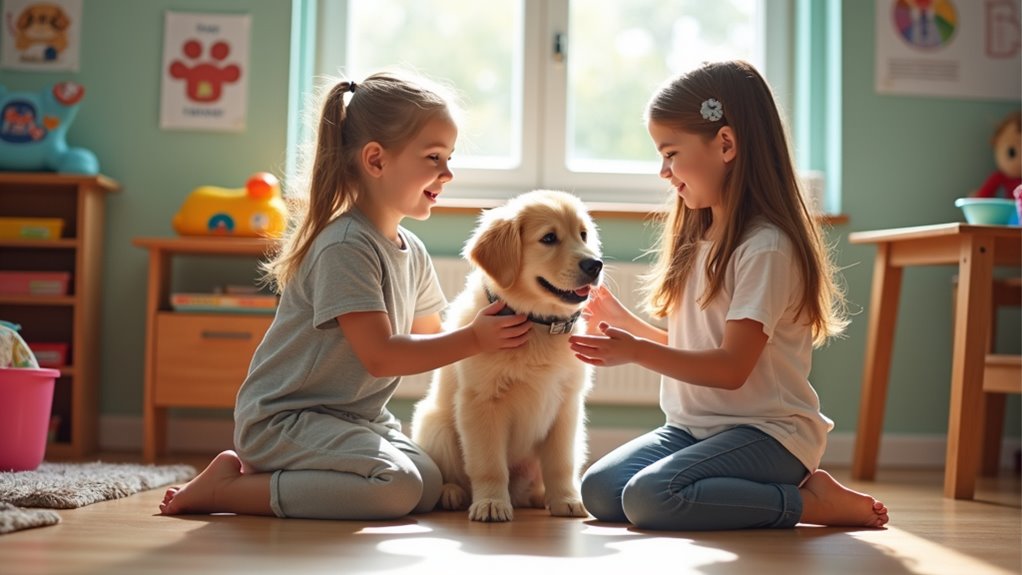To teach children how to safely interact with animals, always supervise their contact. Show them how to handle pets gently, ask permission before petting, and recognize when animals need space. Educate your child on pet cues like growling or hiding to prevent bites or scratches. Establish clear boundaries about touchable areas, and model calm, respectful behavior. Following these guidelines helps build trust and safety—keep exploring to discover more effective ways to promote positive pet interactions.
Key Takeaways
- Supervise all interactions to ensure safety and teach respectful pet handling.
- Teach children gentle petting techniques and explain why rough behavior is harmful.
- Help kids recognize animal cues indicating discomfort or need for space.
- Encourage asking permission before petting and respecting the pet’s boundaries.
- Follow vetted safety guidelines and promote calm, supervised interactions to build trust.

Have you ever wondered how kids and pets can form a lifelong bond? It’s a beautiful connection that brings joy, companionship, and learning opportunities for both sides. But creating a safe environment where children and animals can interact positively requires understanding some key principles. Pet safety is paramount, and that’s why child supervision is so important during every encounter. When you actively oversee interactions, you help prevent accidents and ensure that both your child and pet feel secure and respected.
Supervising your child’s interactions with pets isn’t just about keeping everyone safe; it’s about teaching respect and gentle behavior. Kids often have boundless energy and curiosity, which can sometimes lead to rough handling or unintended discomfort for animals. By supervising, you can guide your child on how to approach a pet calmly and kindly. For example, you might teach your child to avoid pulling on fur or ears and to recognize signs that a pet is uncomfortable, like growling or hiding. This supervision isn’t just a safeguard—it’s a chance to instill empathy and understanding.
Supervision teaches kids respect, gentle handling, and empathy for pets’ comfort and boundaries.
When it comes to pet safety, setting clear boundaries is essential. Make sure your child knows which parts of the pet’s body are okay to touch and which aren’t. For younger children, you might demonstrate gentle petting and explain why it’s important to be gentle. Encourage your child to ask permission before petting a dog or cat, fostering respect for the animal’s feelings. Also, teach your child that animals aren’t toys—they have preferences and feelings, and respecting their space is vital for a positive relationship. Never leave young children alone with pets, especially large or unfamiliar ones, as this can lead to accidental bites or scratches.
Another key aspect is teaching your child to recognize when a pet needs space. If a pet is hiding, hissing, or trying to move away, your child should understand that it’s time to give the animal some quiet and space. Reinforcing pet safety also means showing your child how to handle animals gently, never startling them, and understanding the importance of calm, slow movements. This helps prevent accidental injuries and build trust between your child and the pet. Additionally, understanding vetted pet safety guidelines can further enhance their awareness and prevent potential accidents.
Ultimately, fostering a safe interaction between kids and pets hinges on active supervision and clear boundaries. When you’re present and attentive, you teach your child how to be respectful and gentle, while also protecting the pet’s well-being. This balanced approach creates a harmonious environment where both your child and pet can thrive, learn, and form a genuine, lifelong bond.
Frequently Asked Questions
How Can I Tell if My Child Is Allergic to Pets?
If you wonder whether your child is allergic to pets, watch for pet allergy symptoms like sneezing, itchy eyes, or skin rashes. To confirm, consider allergy testing options such as skin prick tests or blood tests, which can accurately identify sensitivities. If symptoms appear after pet contact, consult an allergist promptly to determine if your child has a pet allergy and discuss the best way to manage it.
What Should I Do if My Child Is Bitten by an Animal?
If your child gets bitten by an animal, act quickly by cleaning the wound with soap and water to prevent infection. Apply pressure to stop bleeding and use a clean cloth. Seek medical attention immediately for animal bite prevention, especially if the bite is deep, bleeding heavily, or shows signs of infection. Follow first aid steps carefully and contact a healthcare professional to assess if rabies or other vaccinations are needed.
Are Certain Pet Breeds Better for Families With Young Children?
When choosing a pet, consider breed suitability for your family. Some breeds are known as family-friendly pets because they tend to be gentle, patient, and good with kids. For example, retrievers and poodles often fit well in households with young children. You should research and select breeds recognized for their temperament, ensuring your choice aligns with your family’s lifestyle and safety needs. This approach helps foster positive, safe interactions between your kids and pets.
How Do I Introduce a New Pet to a Toddler?
Imagine your home transforming into a bustling zoo! When introducing a new pet to your toddler, take it slow. Start with a calm, quiet pet introduction in a neutral space, letting your child observe and gently interact under supervision. Encourage positive toddler interaction, like talking softly or offering treats. Always watch closely, ensuring safety and comfort for both your child and the pet, making the experience joyful and stress-free.
What Are Signs of Stress or Fear in Children Around Animals?
When observing children around animals, look for signs of stress or fear through their body language and emotional cues. If they stiffen, back away, or avoid eye contact, these indicate discomfort. Watch for sudden crying, trembling, or vocalizations that show they’re overwhelmed. By paying attention to these signals, you can step in to reassure or give them space, helping them feel safe and supported during interactions.
Conclusion
Remember, teaching kids how to safely interact with pets is essential for everyone’s safety and happiness. Did you know that children are involved in about 75% of animal bites? By supervising interactions and teaching respectful behavior, you can reduce this risk. Encourage gentle touch and calm voices, and always watch their reactions. With these simple steps, you help create a safe, loving environment where kids and pets can enjoy each other’s company without harm.










